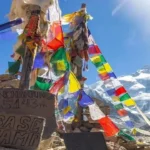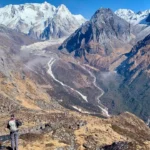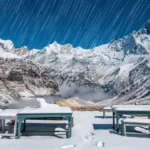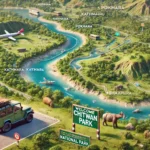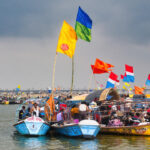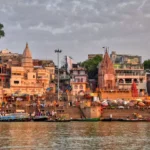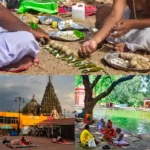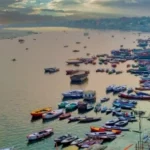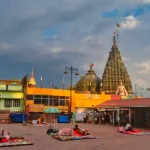What is Koshi Tappu Wildlife Reserve? An Overview
- Location: Eastern Terai region of Nepal, straddling Sunsari, Saptari, and Udayapur Districts.
- Area: 175 square kilometres (68 sq mi) reserve, plus a surrounding buffer zone of 173.5 square kilometres (67.0 sq mi) established in 2004.
- Established: 1976.
- Geography: Primarily a flat floodplain of the Sapta Koshi River, characterised by wetlands, marshes, mudflats, reed beds, grasslands (phanta), and riverine forests.
- Altitude: Ranges from 75 to 81 meters (246 to 266 ft).
- Key Purpose: Initially established to protect the last remaining herds of Wild Water Buffalo (Bubalus arnee) in Nepal. Its scope has since broadened to encompass the entire wetland ecosystem and its rich biodiversity.
The landscape of Koshi Tappu is dramatically shaped by the mighty Sapta Koshi River, one of the three main tributaries of the Ganges system originating from the high Himalayas. The reserve lies on the river’s floodplain, meaning its environment is dynamic, subject to seasonal flooding during the monsoon (typically June to September). This flooding, while sometimes challenging, is crucial for maintaining the wetlands that make this area so ecologically rich.

The construction of the Koshi Barrage just south of the reserve in 1962 significantly altered the river’s dynamics. While intended for irrigation and flood control, the barrage has impacted sediment deposition and water flow within the reserve, contributing to the specific wetland conditions observed today.
Why is Koshi Tappu Wildlife Reserve So Important? Ecological Significance
Koshi Tappu’s importance extends far beyond Nepal’s borders. Its unique characteristics have earned it international recognition:
1. Ramsar Site Designation (1987)
In December 1987, Koshi Tappu was declared Nepal’s first Ramsar Site, recognising it as a Wetland of International Importance under the Ramsar Convention. This designation highlights the critical role the reserve plays in conserving wetland biodiversity and functions. Ramsar Sites are selected based on criteria related to representative, rare, or unique wetland types, and for their importance in conserving biological diversity, especially water birds. Koshi Tappu fulfils these criteria exceptionally well, supporting a vast array of wetland-dependent species.
2. Important Bird and Biodiversity Area (IBA)
BirdLife International recognises Koshi Tappu as one of Nepal’s 37 Important Bird and Biodiversity Areas (IBAS). This designation underscores its global significance for bird conservation. To qualify as an IBA, a site must meet specific criteria, such as regularly holding significant numbers of globally threatened species, restricted-range species, biome-restricted species, or substantial congregations of migratory or resident birds. Koshi Tappu excels in hosting threatened species like the Swamp Francolin and Bengal Florican, as well as enormous numbers of migratory waterbirds.

3. The Last Stronghold of the Wild Water Buffalo (Arna)
Perhaps the most defining feature for mammal conservationists is that Koshi Tappu Wildlife Reserve is the last remaining habitat for the Wild Water Buffalo (Bubalus arnee), locally known as “Arna,” in Nepal. This species is globally endangered, distinct from the domesticated water buffalo. The reserve was initially gazetted specifically for their protection. While the population has faced challenges, including habitat changes and potential hybridisation with domestic buffalo, dedicated conservation efforts focus on securing their future within the reserve. Seeing these magnificent, large-horned bovines in their natural wetland habitat is a unique and rewarding experience.
A Haven for Avian Life: Koshi Tappu Wildlife Reserve – The Birdwatching Paradise
If there’s one thing Koshi Tappu is universally celebrated for, it’s birds. With over 514 bird species recorded (as of recent counts, though numbers often fluctuate slightly with new sightings), it represents an astonishing diversity within a relatively small area. This includes resident birds, summer migrants, winter migrants, and passage migrants.
Why So Many Birds?
- Strategic Location: Situated on a major north-south migratory flyway between Siberia/Tibet and India/Sri Lanka.
- Diverse Habitats: The mosaic of wetlands (marshes, oxbow lakes, reed beds), grasslands, and riverine forests provides niches for a wide variety of species.
- Abundant Food: The wetlands teem with fish, amphibians, insects, and aquatic vegetation, providing ample food resources.
- Relatively Undisturbed: As a protected area, it offers a safer refuge compared to the surrounding agricultural landscapes.
Key Bird Species and Highlights:
Birdwatchers flock to Koshi Tappu hoping to glimpse some of its rare and special inhabitants. Highlights include:
- Waterbirds: The sheer number and variety of ducks, geese, waders, storks, ibises, egrets, herons, and terns are staggering, especially during migration seasons. Look for Bar-headed Geese, Ruddy Shelduck, Northern Pintail, Gadwall, Eurasian Wigeon, Common Pochard, Tufted Duck, Black-necked Stork, Lesser Adjutant, Asian Openbill, Glossy Ibis, Black-headed Ibis, and numerous sandpipers and plovers.
- Globally Threatened Species: Koshi Tappu is crucial for several endangered and vulnerable birds. Key sightings include:
- Swamp Francolin (Vulnerable): This grassland specialist finds refuge here.
- Bengal Florican (Critically Endangered): Although extremely rare and difficult to spot, the reserve’s grasslands are potential habitat for this elusive bustard. Sightings are infrequent.
- Baer’s Pochard (Critically Endangered): A rare winter visitor.
- Indian Skimmer (Endangered): Sometimes seen foraging along the river.
- Yellow-breasted Bunting (Critically Endangered): A passage migrant that may stop over.
- Raptors: The reserve attracts various birds of prey, including the Pallas’s Fish Eagle, Grey-headed Fish Eagle, Osprey, White-tailed Eagle (rare winter visitor), Greater Spotted Eagle, Eastern Imperial Eagle, Peregrine Falcon, and various harriers hunting over the grasslands and marshes.
- Grassland Specialists: Besides the Swamp Francolin, look for Striated Grassbird, Bristled Grassbird, and various pipits and warblers inhabiting the extensive phanta (grasslands).
- Other Notables: Pied Harrier, Watercock, Pheasant-tailed Jacana, Bronze-winged Jacana, Bluethroat, Siberian Rubythroat (winter), various kingfishers, bee-eaters, and woodpeckers.

Best Time for Birdwatching:
While birds are present year-round, the prime birdwatching season is from October to May.
- Autumn (October-November): Pleasant weather, arrival of early winter migrants.
- Winter (December-February): Peak season for migratory ducks, geese, waders, and raptors. Huge congregations can be seen. The weather is generally clear and dry.
- Spring (March-May): Departure of winter migrants, arrival of summer visitors and passage migrants. Breeding activity begins for resident species. Temperatures start to rise.
The monsoon season (June-September) sees heavy rains, high water levels, and reduced accessibility, making birdwatching more challenging, although resident species and some summer visitors are still present.










